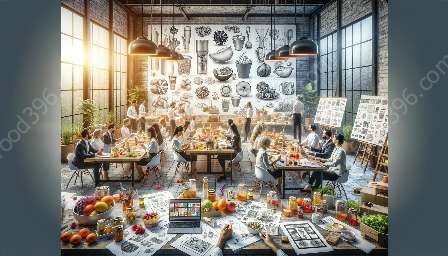Food sensory perception plays a crucial role in the multi-faceted realm of product development and culinology. It involves the intricate processes of how we perceive and interpret the sensory attributes of food, including taste, aroma, texture, and appearance. Understanding the complexities of sensory perception is essential for creating food products that captivate the senses and provide an unparalleled culinary experience.
The Role of Sensory Perception in Product Development
In the realm of product development, understanding food sensory perception is pivotal for creating food and beverage products that resonate with consumers. Sensory attributes such as flavor, aroma, texture, and visual appeal significantly influence consumer preferences and purchasing decisions. By leveraging insights into sensory perception, product developers can fine-tune formulations to meet consumer expectations and deliver exceptional sensory experiences.
Taste Perception
Taste perception, also known as gustation, is a fundamental aspect of sensory perception. The five primary tastes—sweet, salty, sour, bitter, and umami—interact with taste receptors on the tongue, providing a diverse range of sensory experiences. The complex interplay of taste compounds and their interactions on the palate contributes to the overall flavor profile of foods and beverages.
Aroma and Olfactory Perception
The sense of smell, or olfactory perception, is intricately linked to taste and greatly influences our overall sensory experience. Aroma compounds in food products contribute to their perceived flavor profiles and can evoke powerful sensory memories. Product developers harness the power of aromas to create captivating food and beverage formulations that engage the olfactory senses and enhance the overall eating experience.
Texture and Mouthfeel
Texture and mouthfeel are integral components of sensory perception that significantly impact how consumers perceive and enjoy food products. The tactile sensations and structural properties of food items, such as crispness, creaminess, and chewiness, contribute to the overall sensory experience. Understanding and optimizing texture attributes are critical for developing products that offer a satisfying and delightful mouthfeel.
Visual Perception
Visual cues play a crucial role in shaping our perceptions of food and beverage products. The color, shape, and presentation of food items influence consumer expectations and can evoke emotional responses. Product developers employ visual cues to create visually appealing food products that entice consumers and enhance the overall dining experience.
Sensory Perception and Culinology
In the realm of culinology—the merging of culinary arts and food science—sensory perception takes center stage. Culinologists leverage a deep understanding of sensory attributes to innovate and elevate culinary experiences through the fusion of culinary artistry and scientific principles. By exploring the intricate interplay of taste, aroma, texture, and visual appeal, culinologists craft culinary creations that stimulate the senses and delight the palate.
Sensory Evaluation in Culinary Innovation
Culinology involves rigorous sensory evaluation techniques to assess the organoleptic properties of food products. By employing sensory analysis methods such as descriptive analysis and consumer taste testing, culinologists gain valuable insights into consumer preferences and sensory perceptions. These insights drive the creation of innovative culinary concepts that resonate with today’s discerning consumers.
Multi-Sensory Dining Experiences
Through the innovative application of sensory science, culinologists engineer multi-sensory dining experiences that go beyond taste and aroma. The integration of visual presentation, texture variations, and aroma diffusion techniques creates immersive culinary encounters that engage all facets of sensory perception. Culinary professionals collaborate with food scientists to conceptualize and execute multi-sensory dining concepts that elevate the art of gastronomy.
Conclusion
In conclusion, food sensory perception is a captivating intersection of science and art that significantly influences product development and culinology. By unraveling the complexities of taste, aroma, texture, and visual perception, food innovators can craft exceptional products and culinary experiences that resonate with consumers on a profound sensory level. Embracing the nuances of sensory perception is the key to creating memorable culinary offerings that leave a lasting impression on the senses and the soul.

